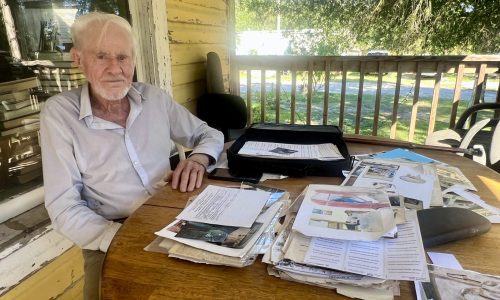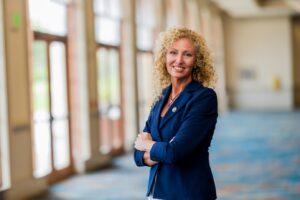An Interview With 98-Year-Old World Sailor, Draftsman, and Model Maker Robert “Bob” Kipp
By Katrina Salokar. EastLeeNews.com
The porch of the old Sears Roebuck house at Belle Hatchee Marina breathes in its own rhythm. Its wavy glass windows catch the afternoon light in a softened glow as the Caloosahatchee River drifts steadily behind it. That is where I found Robert “Bob” Kipp, almost ninety-nine years old, sitting in a wooden chair like a man who has finally earned a gentle place to land. Boats nudged quietly in their slips, cats wound calmly around our feet, and the whole place felt as if time had paused just long enough to let a century of memories come forward.
Bob smiled when I sat down across from him, the kind of smile that carries humor, patience, and long stories. His hands rested on the chair arms, hands that had built airplanes, boats, wartime cargo boxes, jewelry stores, six-foot architectural models, and a trimaran that would carry him around the world. When he began to speak, it was with the straightforward clarity of a man who has spent his life building instead of boasting. “I was born on December 5, 1926,” he said. “Almost ninety-nine now. Doesn’t seem possible.” He laughed the way old sailors do, treating age like an old companion rather than a burden.
His childhood was simple, and he never pretends otherwise. “I flunked first grade twice,” he said, shaking his head. “Country school. One teacher for eight grades. They sent me back.” His mother, a fiery Frenchwoman, pulled him out of the country school and put him in town school instead. He spent four summers in a row attending summer school, working to catch up. “I wasn’t supposed to be anything special,” he told me. “But I liked drawing. I liked building things. That got me started.” By the age of twelve, he was a draftsman in a sheet-metal shop. At fourteen, he was designing military cargo boxes that supported the country’s wartime supply chain. While other boys were driving tractors, Bob was sketching the designs that shipped America’s equipment overseas.
When World War II arrived, Bob enlisted hoping to become a fighter pilot. He passed every test, but the war ended before he could be placed in a training class. His unit was mistakenly shipped overseas anyway, their paperwork lost twice. “We lived on K-rations in France and Belgium,” he said. “Stayed in an orphanage for a while. Six months before the Army figured out where we were supposed to be.” He later served during the Korean War as well, again nearly landing in combat before being sent to England for drafting work. “I went where they needed me,” he said simply.
Bob’s life before sailing was defined by building. He drafted for construction companies, designed kitchens in Australia, built jewelry stores in Lahaina, created collapsible architectural models that could travel as airplane cargo, and even designed a collapsible airplane he flew over Central America. His hands, even at ninety-eight, still moved with the precise confidence of a draftsman as he sorted through photographs on the porch table. “You don’t just decide to sail around the world,” he told me. “You build your way there.”
It took him four years to build the first trimaran, one small section at a time as he earned money to buy materials. In 1972, he set off from Long Beach for Hawaii. But he didn’t stay alone long. Her name was Trudy, a recently divorced woman looking to escape, to reinvent, to step into a different kind of life. They met in Long Beach, and she told him she wanted to sail. She needed to sell her house first, so he left for Hawaii without her. A year later, she flew over and stepped aboard. “No fights,” he said, his voice warm with memory. “She was good. We worked together.” Trudy was an artist, bright and gifted; one of her paintings now hangs in the Brisbane Museum in Australia. For twenty-five years they lived, worked, traveled, and built side by side before she passed away about a decade ago. “We were good together,” he said softly.
From 1972 to 1978, Bob and Trudy sailed around the world, earning their way through ports by crafting architectural models from colored mat board and Elmer’s waterproof glue. He showed me photos of the tiny buildings, churches, boats, kitchens, and storefronts he built in port towns all over the world. “Sometimes we made good money,” he said. “Sometimes nothing. Sometimes the pay was a meal. But the models kept us going.” In Australia he designed kitchens; in South Africa he built round houses for families preparing for political upheaval; in Lahaina he helped build jewelry stores; in countless ports he created small models for captains and business owners. “Some of the ones we gave away for free,” he said with a grin, “we enjoyed the most.”
I asked him which places stayed with him the most. South Africa came first. “People loved each other more than the politics let on,” he said. Somalia was the most rural, “the toilet was a hole in the ground”, and Australia had the best food. “They’re meat eaters. Big steaks, thin but as wide as the whole plate.” But his best single meal came on Bonnaby Island, where the locals cooked shark for the two travelers. “Best shark I ever tasted,” he said. His scariest moment was Hurricane Bebe. “We got caught in the outer bands,” he said. “We were becalmed, and then the winds hit. If that hurricane hadn’t shifted, that would’ve been it.” He stopped, letting the memory settle. Some moments, even after half a century, return with sharp edges.
Bob and Trudy arrived in LaBelle in the early 1990s. “We stopped here, and then we stayed.” He lived on his trimaran at the Belle Hatchee Marina, cleaning leaves for exercise, talking with neighbors, and finding a peaceful rhythm along the water. When I asked him the secret to living so long, he answered without hesitation: “Nitrogen. Opens the blood vessels. More oxygen.” He eats beets, celery, carrots, and drinks beet juice regularly, though he insists anyone trying it should talk to a doctor first. “But the work saved me,” he added. “Building the boat. Sailing the boat. Those were the prime years.”
After all he has lived, built, and survived, I asked him what he considers his greatest achievement. His answer was immediate. “Sailing my own boat around the world. Building it with my own hands. Sailing it with one crew, one good woman. That was the prime time of my life.”
As the sun dropped behind the trees, Bob spread photographs across the old porch table, boats, parades, ports, planes, models, beach parties, shark feasts, friends, and moments from a life made of movement and curiosity. “We got enough to write a whole bible,” he said, smiling. Maybe he’s right. Or maybe what he has given us is something even better: a reminder that a life well lived isn’t shaped by one big moment, but by thousands of small ones, built by hand, guided by courage, and carried forward by the wind.








